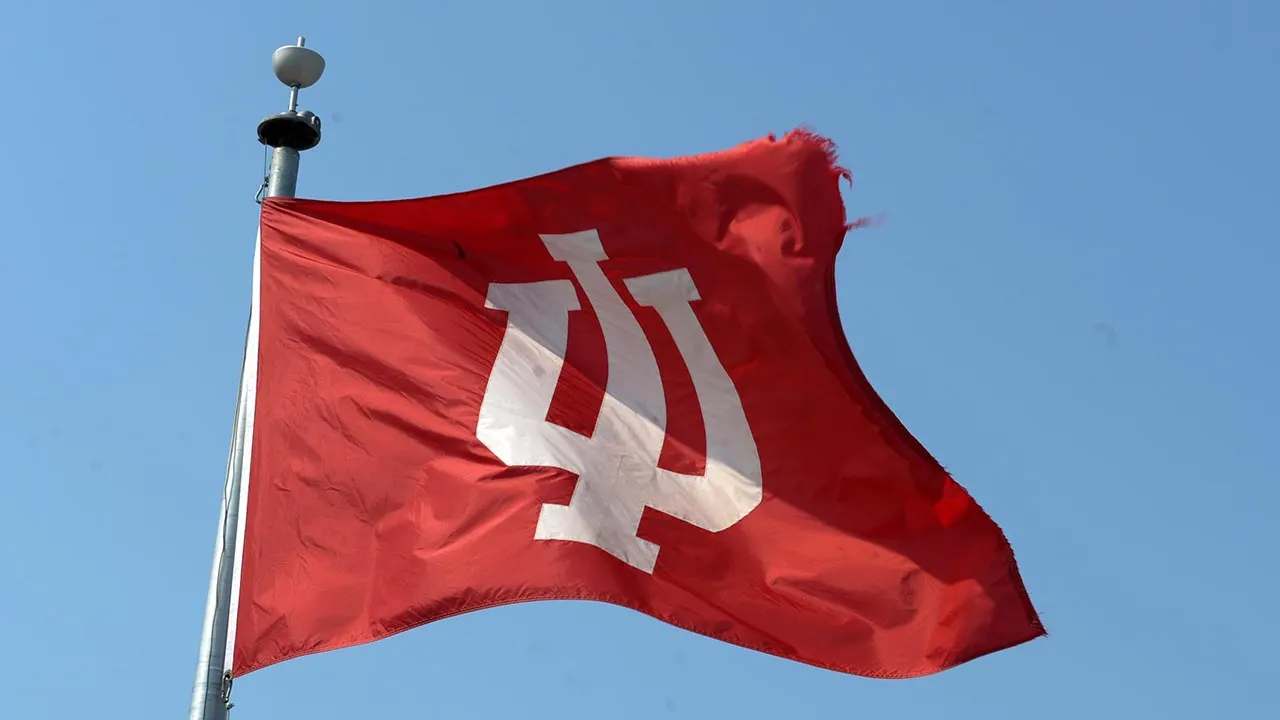Eric Froton is previewing every Big Ten squad by looking back at their 2022 season, breaking down any changes in 2023, analyzing their rosters and handicapping their win total for the season.
Today we look at the rebuilding Indiana Hoosiers:
Indiana
HC – Tom Allen (7th year)
OC – Walt Bell (2nd year)
Co-DC – Chad Wilt (2nd year)
Co-DC – Matt Guerreri (1st year) (PC)
2022 Record: 4-8
Second Order Win Total: 2.7 (-1.3)
2022 Over/Under: 4.5 Wins
Points/Yards Per Game: 23.3 points | 328 yards (217 pass | 111 rush)
Points/Yards Allowed: 33.9 points | 449 yards (274 pass | 175 rush)
2023 SP+ Overall: 71st
2023 SP+ Offense: 61st
2023 SP+ Defense: 82nd
2022 SP+ Special Teams: 76th
Offensive Returning Production: 48% (107th)
Defensive Returning Production: 44% (119th)
247Sports Avg. Offensive Player Rating: .8603 (44th)
247Sports Avg. Defensive Player Rating: .8569 (45th)
Pace of Play: 20.6 seconds per play (5th) | 74 plays per game (15th)
2023 Schedule Strength: 16th
Looking Back at 2021 & 2022
In 2020 everything came together for the Hoosiers, as they went 6-1 playing an exclusively Big Ten schedule, beating Penn State, Michigan and Wisconsin while losing a very competitive game against Ohio State by one score. In 2021 however, their rising star OC Kalen DeBoer left to become HC of Fresno State (now HC of Washington) and the dropoff was steep, with IU falling to 2-10 while averaging 17.3 points (123rd) and 290 yards (124th) per game. The Hoosiers eclipsed the 15 point mark just three times against FBS opponents and finished with the fifth-lowest big play rate in the country (8%).
Year 1 of new OC Walt Bell’s tenure saw IU actually increase their points per game output from 17-to-23 PPG, while tacking on an extra 38 total yards from their disastrous 2021 offense. Indiana returned three offensive linemen from a group that cleared the way for the fourth fewest line yards in the nation (2.1 line yards per carry) and allowed a 35% pressure rate (109th) in 2021. Honorable Mention All-Big Ten RT Matthew Bedford was out for the year after Week1 due to injury and the results were not pretty. Indiana was stopped for no gain a staggering 24% of the time (124th) with a 39% overall rushing success rate (115th) and a brutal 2.22 line yards per carry average (125th).
They weren’t much better in pass pro either, charting a 33.6% pressure rate (117th), 1.8% blown block rate (109th) and 19% havoc rate allowed (115th). With the Hoosiers gaining 68 rushing yards or less in each of their first four games against Power Five opponents, HC Tom Allen was forced to fire the offensive line coach in a desperate attempt to rekindle an extinguished run game. It took a few weeks but Indiana finally woke up in the final three, posting 150 rush yards against @Ohio State, 257 against @Michigan State and 215 versus Big 10 West champs Purdue. Though they still allowed 16 sacks over the last four contests, and managed to complete just 2-of-7 passes for 31 yards against Michigan State’s lackluster secondary, there was still a noticeable uptick in competence from the OL at the end of the year.
Indiana took a big hit in the receiver room, as their top-three pass catchers left, with Emery Simmons arriving from UNC and highly touted JUCO Cam Camper pacing the team in receiving yardage. Camper in particular was a revelation, earning a robust 82 targets with 46 receptions for 569 yards and two touchdowns in just seven games. He reeled in 9-of-22 contested catch opportunities to go with a 1.82 yards per route average while logging 86% of his snaps on the outside despite woeful quarterback play. Starting QB Connor Bazelak simply could not find a rhythm, leading the offense to a 35% passing success rate (114th) while ranking 127th in passing explosiveness with a morose 4.5 yards per attempt average, which was the third-worst mark in FBS.
After fielding a very solid defense in 2020 that allowed just 20 points per game and had 25 sacks through eight contests, Indiana’s 2021 numbers plummeted to 33 PPG allowed with a 13% havoc rate that ranked in the bottom-20 nationally. Their defensive line failed to generate even a modicum of pressure, recording a troubling 3.6% sack rate (127th). The nearly two touchdown increase in PPG set the stage for Indiana’s 2-10 finish that saw the Hoosiers fail to beat a single Power Five opponent the entire year.
Despite hopes for a bounceback in productivity in 2022 the defense got noticeably worse, allowing 34 PPG with their yardage jumping from 386 YPG in 2021 to a devastating 449 YPG (274 pass | 174 rush) last season. The D generated 3-and-outs just 23% of the time (113th) while allowing a 44% overall success rate (92nd) and a 5.5% big play rate that ranked 116th nationally. There were encouraging signs in run defense, as Indiana’s 40% rushing success rate ranked 33rd overall with a stout 52% power success rate that actually ranked 5th nationally. Linebacker Cam Jones recorded an astounding 24 stops with an 89.3 PFF run defense grade in just five games, before suffering a season-ending injury that significantly altered the makeup of the IU defensive front. For perspective, IU allowed just 40 rushing yards to Cincinnati and 115 yards to Nebraska when Jones went down. They went on to allow at least 165 rushing yards in each of their next six games.
There are no such moral victories to be found when it comes to their listless pass defense though, as Indiana got thoroughly destroyed through the air, allowing a 48% passing success rate (124th), 8.8 net yards per attempt (123rd) and a 7.3% touchdown rate (122nd). When 57% of passes are going for first down yardage (118th) with a 65% completion rate, it doesn’t matter how well the run defense performs. As one might expect from a team that allowed 274 passing yards per game with a 30-to-7 ratio, not a single member of the secondary earned a PFF cover grade of 70 or above.
Looking ahead to 2023
Indiana is undergoing a restructuring of the roster following the loss of 41 lettermen, as just 8 total starters return with the new freewheeling transfer portal rules contributing to the massive turnover. In an effort to try and cobble together a Big Ten caliber roster the Hoosiers also dipped into the transfer market, bringing in a whopping 25 new collegiate players to fill the talent gaps.
Second year OC Walt Bell addressed a leaky offensive line that allowed 38 sacks and a 19% havoc rate (115th) last year by snapping up former Wisconsin OL coach Bob Bostad. Four linemen who ended the year as starters return, including sophomore Kahlil Benson who started the last five games at right tackle in relief of Parker Hanna, who allowed an eye-popping 40 pressures in 503 snaps. The return of 2021 honorable mention All-Big Ten RT Matthew Bedford allows Benson to kick inside to RG, strengthening both positions. Michigan transfer Zach Carpenter moves to center full time while LG Mike Katic allowed a respectable 14 pressures 572 pass snaps. The backfield committee will be led by Sr. Josh Henderson (79.3 PFF rush grade/3.0 YAC/1.84 yards per route) and speed back Jaylin Lucas (50 carries/5.4 YPC/3.8 YAC), while Wake Forest transfer Christian Turner will also factor in the mix.
Last year’s starting QB Connor Bazelak is now at Bowling Green, so IU is pinning their hopes on Tennessee transfer rFr Tayven Jackson, who sought a fresh start following the signing of five-star 2023 QB Nico Iamaleava. Jackson was rated as a four-star transfer who was the 12th quarterback from the 2022 prep cycle, earning an Elite 11 showcase invitation. The addition diminishes QB Dexter Williams’ chances of playing here, with true freshman Broc Lowry serving as Jackson’s understudy.
The WR1 role will be reprised by Cam Camper who should receive 100+ targets in OC Bell’s up-tempo, pass-heary offense that ranked 119th with a 46% standard downs run rate (national average: 58%). The lightning fast offense ripped off a play every 20.6 seconds, which is the fifth quickest pace in the nation. So if Fordham transfer WR DeQueece Carter (1,168 rec yards, 12 TDs last year) can be a credible threat opposite Camper, it would do wonders for QB Jackson’s development.
On defense, the losses are massive with 9 of the top 10 tacklers moving on from the program, leaving just two returning starters from their porous 2022 unit. DE Andre Carter (90.1 PFF pass rush grade/54 pressures/32 stops in 2022) by far the most experienced defensive lineman, as the Western Michigan transfer with 1,664 snaps under his belt spanning five seasons. He is joined by six Power Five transfers who were lured to Bloomington with the promise of an increased role. With last year’s DL recording a downright awful 2.3% havoc rate that ranked 3rd-worst in the country, the fate of the defense rests upon the ability of new DC play caller Matt Guerreri to integrate the newcomers quickly.
The strength of the defense is clearly the linebackers, with WLB Aaron Casey (86 tackles/15% tackles per snap/2.5% havoc rate) and “Husky” Noah Pierre (3.0 sacks/4 PBU/2.2% havoc rate) being the only two returning starters. However, Pierre will need to clean up his subpar 25% missed tackle rate which contributed to a team-low 46.1 PFF run defense grade. MLB Jacob Mangum-Farrar transfers in from Stanford, where he started 11 games the last two years. He rarely lets rushers out of his grasp, as his 8% missed tackle rate is a solid mark, but he allowed a 130.4 NFL passer rating when targeted in coverage and was saddled with a dirt-low 36.9 PFF overall defensive grade last season.
CB1 Tiawan Mullen will be sorely missed, as the three top projected corners are all transfers. Former Texas Tech CB Kobee Minor has logged just 161 reps in three seasons with zero starts under his belt, while Jamier Johnson allowed completions on 12-of-16 targets for 180 yards and two touchdowns last season as a part-timer at Texas. SS Josh Sanguinetti has shown promise in coverage with a solid 42.5 passer rating allowed thus far in his career. Though as a strong safety his 24% missed tackle rate must get better.
It’s hard to project a drastic improvement defensively considering the massive losses.
Analyzing Indiana’s Win Total
Indiana has the pleasure of welcoming Ohio State to Memorial Stadium in Week 1 before a feel-good matchup against an Indiana State program that hasn’t been relevant since Larry Bird went there. Week 3 has new HC Jeff Brohm’s passing-rich Louisville offense traveling to Lucas Oil Stadium for a neural site tilt before Akron wraps up the non-conference slate. The middle stretch of the schedule is a nightmare, facing @Maryland, BYE, @Michigan, Rutgers, @Penn State and Wisconsin at home. Things lighten up a bit for the home stretch @Illinois, Michigan State, @Purdue.
The Over/Under is set at 3.5 Wins, so assuming the Hoosiers beat Indiana State and Akron, they have to take two games from their Big Ten/Louisville schedule in order to clear this Over. IU went 3-0 to start 2022 before dropping eight of the next nine games, with the lone victory being a double-OT squeaker against Michigan State. The problem is that every team on their schedule improved in some manner, while Indiana is undergoing wholesale changes across the board, especially on defense where they allowed 33.5 PPG each of the last two seasons. It takes a cast iron stomach to bet on this team to clear the 3.5 wins mark, so i’m backing the Under on Indiana this year.






















/cdn.vox-cdn.com/uploads/chorus_asset/file/25822586/STK169_ZUCKERBERG_MAGA_STKS491_CVIRGINIA_A.jpg)

/cdn.vox-cdn.com/uploads/chorus_asset/file/25821992/videoframe_720397.png)




